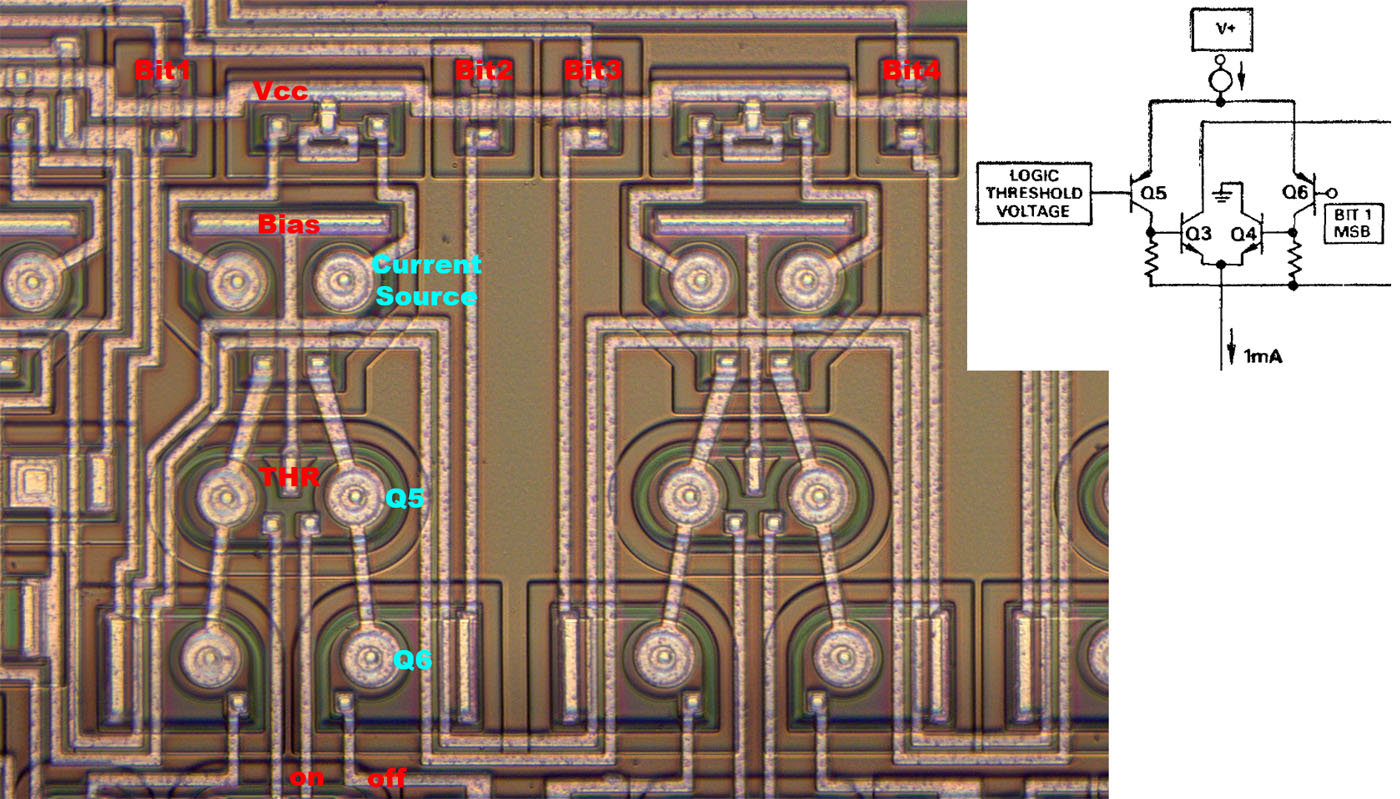
The "Analog-Digital Conversion Notes" show how the digital input signals are processed. It is a differential amplifier built with PNP transistors whose two outputs control the two transistors of the current switch. On one side of the differential amplifier (Q6) the input signal is applied, the potential on the other side (Q5) defines the switching threshold.
On the die the PNP differential amplifiers are arranged in pairs. The top transistor represents the current source. It is controlled from the left side of the die. Below it is the transistor Q5 of the differential amplifier. The current sources and the transistors Q5 use the same base potentials for all inputs, which is why it was possible to integrate them in pairs in the same base area and save silicon area. The second transistor of the differential amplifier (Q6), on the other hand, has an exclusive base area. The two control signals "on" and "off" at the bottom are the output signals.
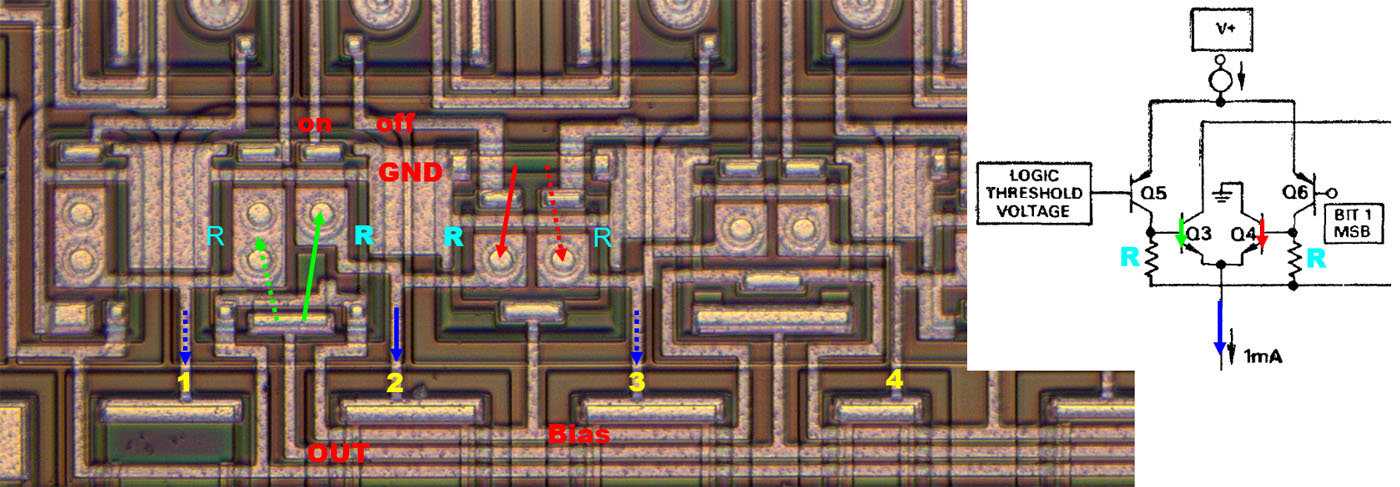
The four switching transistors of adjacent current sinks (yellow/blue) were combined in pairs. Two transistors leading to the output (green) alternate with two transistors neutralizing the current via the ground potential (red). The collector resistors of the controlling transistors (cyan) work against a bias potential.

The routing of the signals over the whole width of the current sinks and changeover switches is not unproblematic with just one metal layer.

There are some capacitor plates connected to the emitter potential of the transistor that sets the reference current. This probably improves the control loop behaviour. The isolated metal surfaces could be reservations to be able to increase this capacity with a small change of the metal layer.
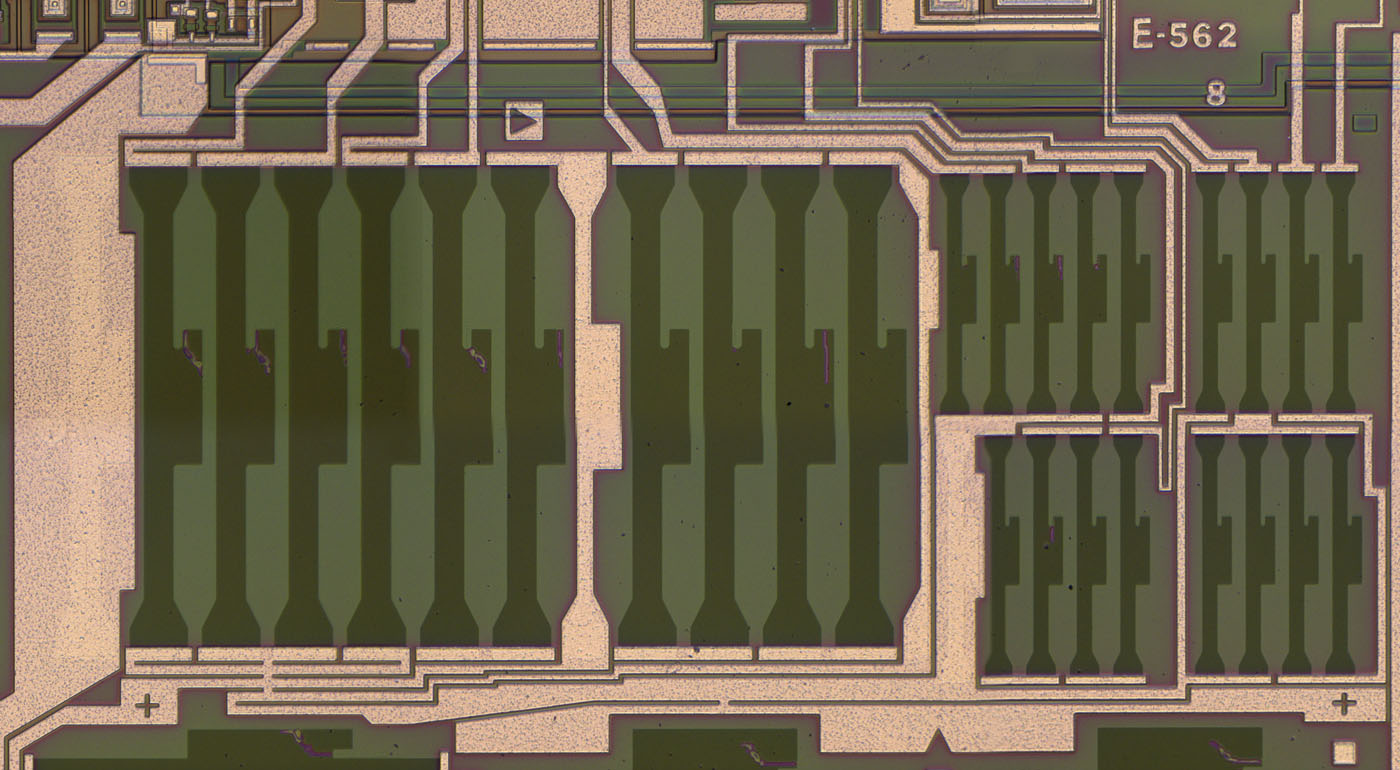
The footpoints of the current sinks are combined in a star configuration as far as possible. This is important so that the current sinks do not disturb each other and can all work with the same reference potential. The negative supply is routed from the bondpad to these resistors over an exclusive line. The upper part of the AD562 is connected via a separate line.
The farther to the left the resistors are in the current sink row, the greater their influence on the overall error of the DAC. For this reason, the large resistors and the first small resistors are surrounded by dummy structures at the edges. They are not visible at first glance because the metal layer hides them. The dummy structures ensure that the resistors at the edges behave as much as possible like the internal ones. This way manufacturing processes have a more uniform effect on the relevant surfaces due to the more homogeneous environment.
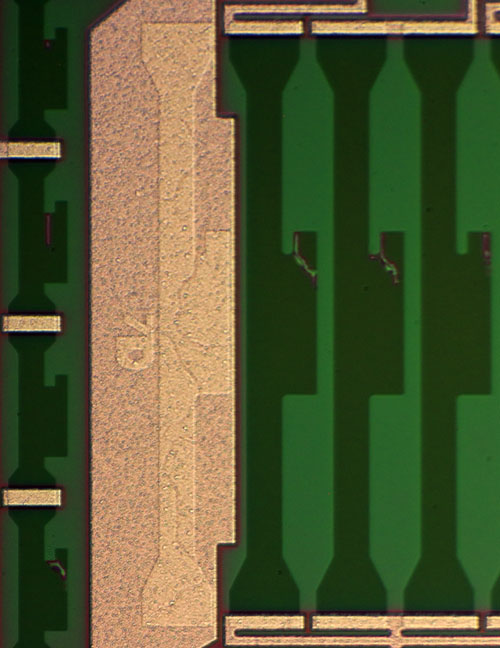
If you vary focus and exposure time the dummy structures become more prominent. On the far left, there is an additional symbol that cannot be interpreted.

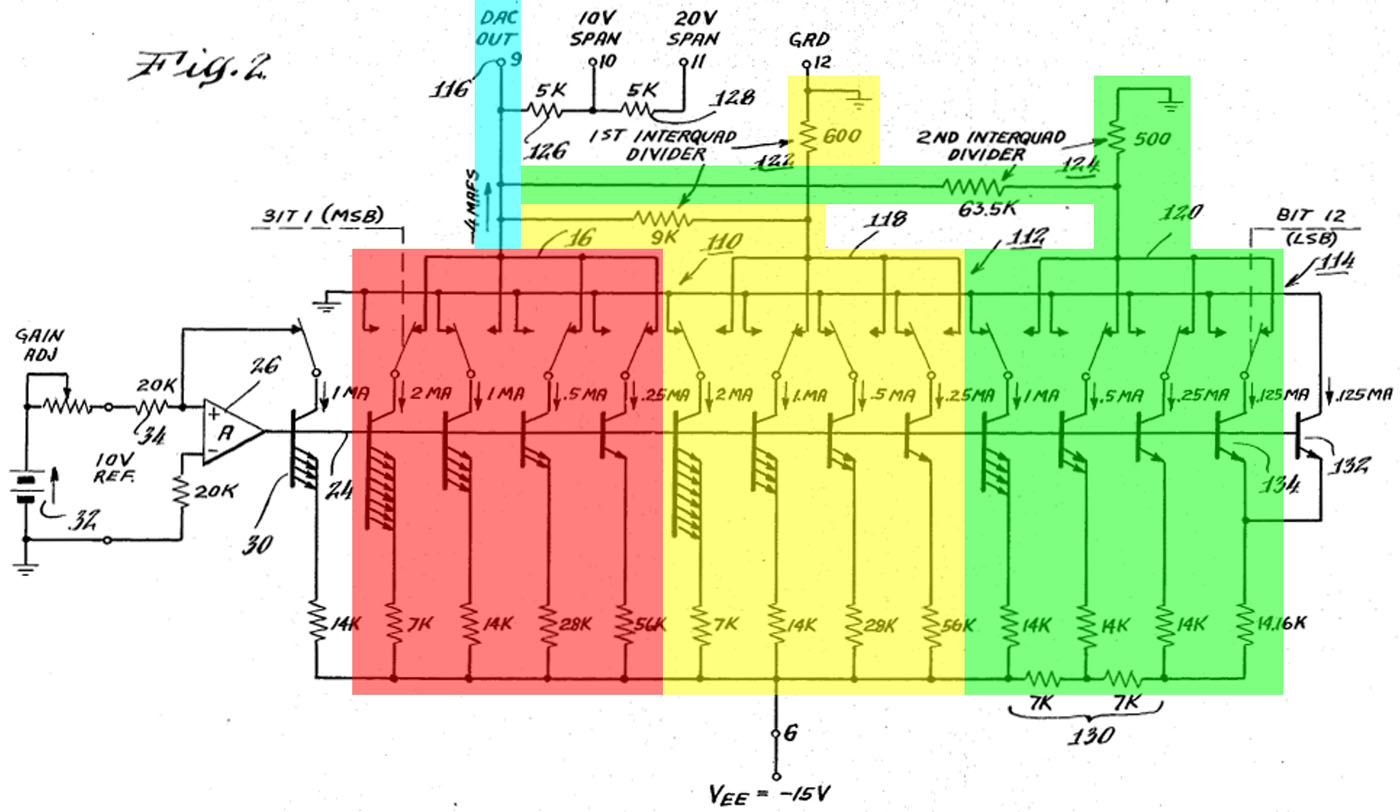
The datasheet of the AD562 refers among other things to the patent US3961326. In this patent the structure of the DAC is shown in more detail. The circuit diagram has been colored for better understanding. The currents are entered incorrectly. With a 10V reference voltage and the 20kΩ resistor the opamp sets a reference current of 500µA, as shown in the schematics above. The remaining currents have to be halved accordingly.
The first group (red) contains four current sinks. Related to the reference current generation, the resistance ratio is 0.5:1:2:4. This provides a current ratio of 2:1:0.5:0.25 or in absolute values 1mA, 500µA, 250µA, 125µA. These current sinks are connected to the output (cyan) depending on the digital input signal.
The second group of current sinks (yellow) has the same structure as the first group. However the output current passes through an "interquad divider", a current divider that reduces the currents by a factor of 16. The exact resistor values differ a little from the resistor values in the documents above, but the factors are the same. The 1/16 current divider is just used by the second group. The third group (green) has its own current divider. Alternatively, one can also work with two 1/16 dividers connected in series as implemented in the DAC-HZ12 for example (
https://www.richis-lab.de/DAC05.htm).
The third group of current sinks (green) has a slightly different structure in detail than the first two groups. Since the error contributions of the current sinks located further to the right have less effect on the output due to the current dividers, the third group can be implemented more simply, which means that the circuit takes up less area on the die. The strongest current sink of the third group takes just 500µA. This is the reason why the second current divider does not have a factor of 1/256 but a factor of 1/128. The first three current sinks of the third group have equal emitter resistances. In order to be able to generate a current ratio of 8:4:2, there are 7kΩ resistors between the current sinks. The sum currents of the following current sinks flow through these resistors. The smallest current sink operates with a 14kΩ emitter resistor too. The division of the current is represented by a second transistor (132) whose output is fixed to the ground potential. Transistors 134 and 132 share the current, which produces the desired current ratio. Finally, the sum current of the third group is connected to the output through the second current divider.
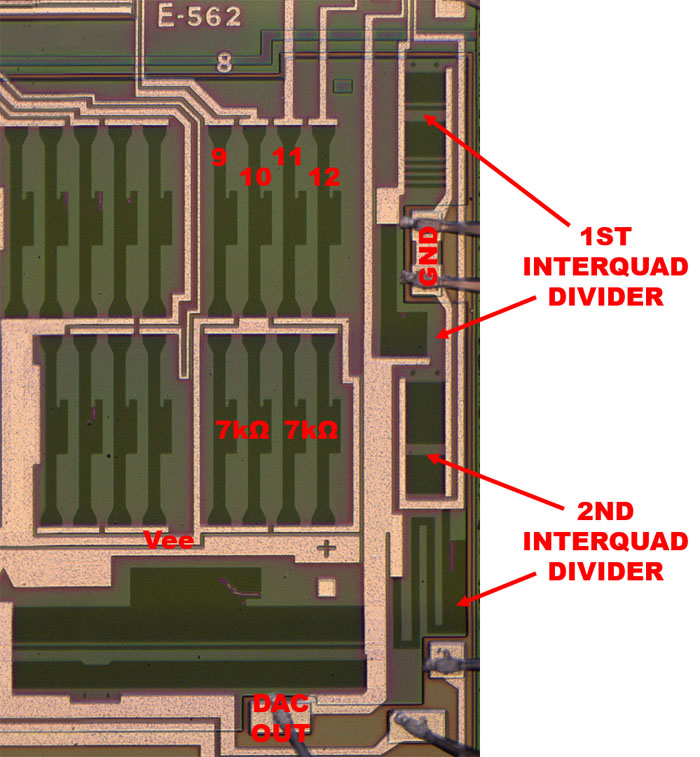
With the background of the patent US3961326 the wiring of the resistors in the AD562 can be understood much better.
The two current dividers on the right edge have an exclusive ground potential, which is connected to the case via two bond wires. Unlike many other currents at critical points in the DAC the currents in the current dividers change with the desired output current. These changes result in varying voltage drops, which in turn can negatively affect the quality of the output signal. For this reason, the currents are diverted through an exclusive lower-resistance path.
The lower resistors of the current dividers were tuned similarly to the resistors in the current sinks. The upper resistors additionally seem to offer the possibility of a very rough adjustment by cutting larger areas completely.

The resistors needed for the external conversion of the output current into a voltage are integrated at the lower edge of the die. This reduces the external part requirements. Since a trimming process is used in the AD562 anyway, it is also very cheap to generate exact resistor values.
Additional resistors are connected in parallel to the adjusted resistors. The notches with the two dots suggest that these resistors were intended for an adjustment too. The resistor for setting a bipolar output voltage consists of two elements. Between these elements is an additional bondpad, so that one can set a different resistor value by varying the bondwires.
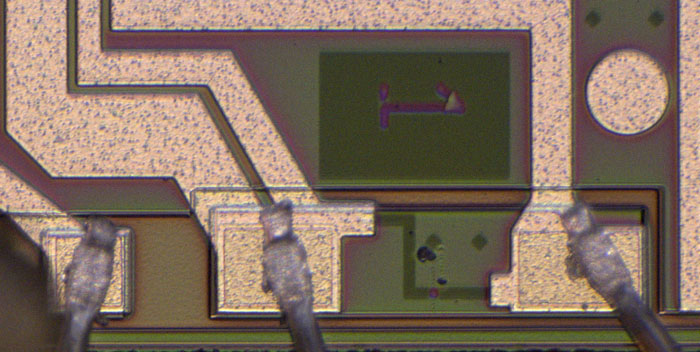
The bondpad BIPOLAR OFFSET R IN has a connection to the negative supply which was cut during the tuning.
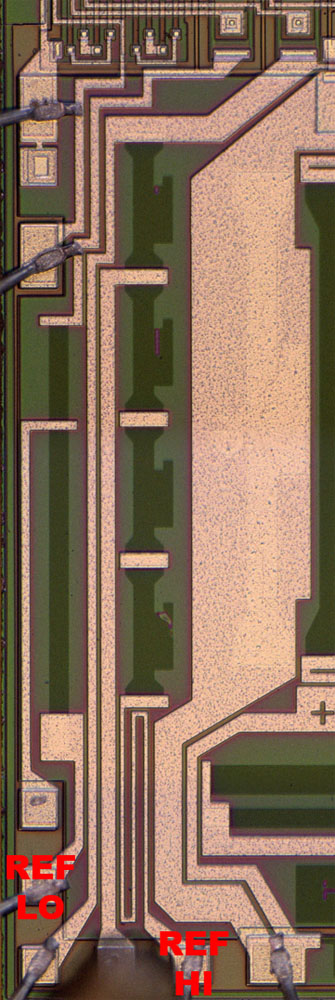
On the left edge of the die there are the two input resistors that lead to the opamp that sets the reference current. The resistor value critical for the reference current at the bondpad REF HI consists of four resistor elements, each of which can be adjusted individually.
Next to the bondpad REF HI there is a free bondpad which is hard to see in this picture. This bondpad makes it possible to contact only a quarter of the REF HI resistor. In the REF LO path there is a tap too. According to the location it gives you a quarter of the resistor too. The tap at a quarter seems to be absolutely logical with regard to the AD563. The AD563 has an additional 2.5V voltage reference. To be able to generate the same currents with the 2.5V the resistance at the input of the reference current control must be reduced to a quarter.
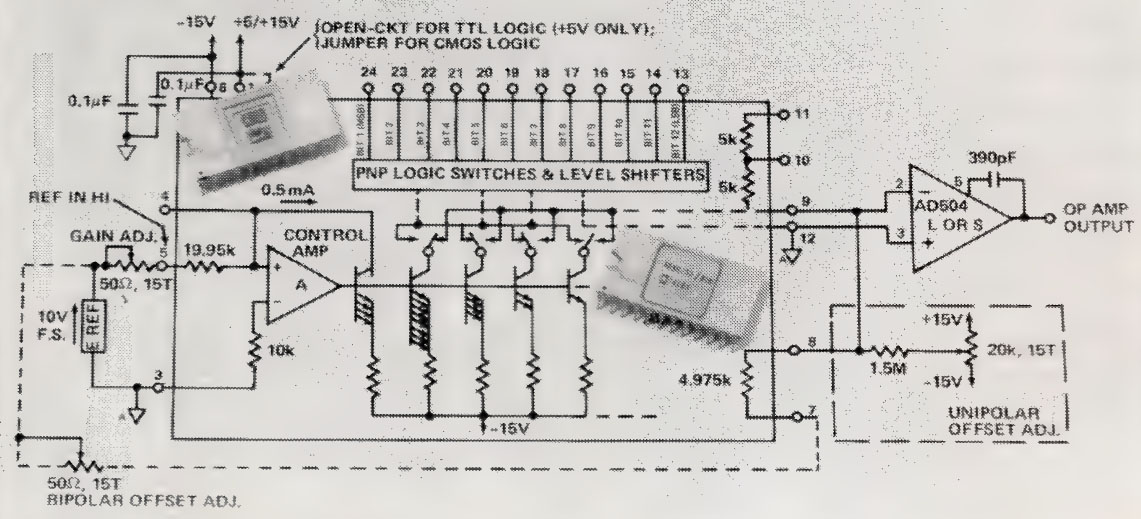
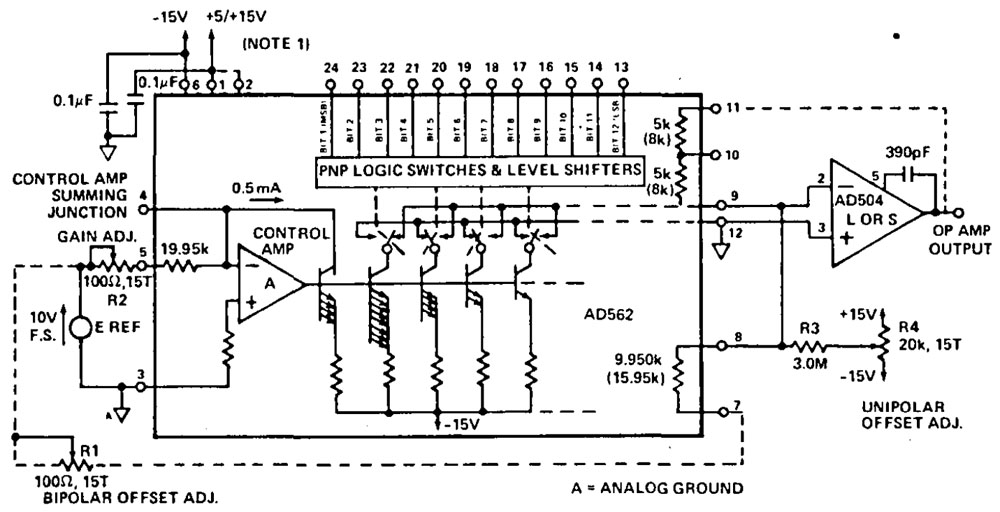
Looking at the schematic published in the magazine EDN (Volume 19, Number 20, 20.10.1974) (above) and the schematic in the "Data-Acquisition Databook 1982" by Analog Devices (below) very different resistors can be found.
According to the EDN magazine, there could be a resistor with a value of 10kΩ at the non-inverting input of the reference current opamp. At the same time, there would be a 20kΩ resistor at the inverting input. This does not seem logical since one usually tries to keep the resistors on both inputs of an opamp the same size so that the effects of the bias currents compensate each other as much as possible. In most documents both resistors are specified as 20kΩ. It is likely that the 10kΩ is a typographical error.
The two resistors for setting the output voltage range are usually specified as 5kΩ. In the "Data-Acquisition Databook 1982" 8kΩ is specified in parentheses as an alternative. This would explain the tapers and the markings on the resistors connected in parallel. Probably one can increase the resistor values to 8kΩ by cutting the parallel strings.
If one increases the 5kΩ feedback resistors one must adjust the resistor for bipolar operation too. In the "Data-Acquisition Databook 1982" this resistor value is accordingly additionally given with 16kΩ. This resistor too offers parallel connected resistors which can be cut. However one could probably alternatively use the center tap to represent the 5kΩ shown in the EDN magazine. In this configuration "bipolar operation" would result in an output current range of 0mA to 2mA, which does not seem particularly useful. The purpose of the alternative 5kΩ resistor is not obvious.

In the present AD562 there are once again other resistors: The resistance at the input of the reference current source can be determined with 22kΩ. The resistors for setting the output voltage range are 5,5kΩ each and the resistor for the bipolar operation offers 11kΩ fittingly.
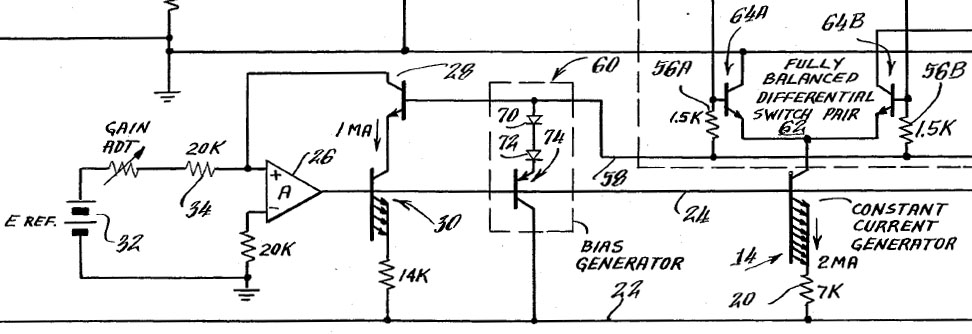
The circuit diagram in patent US3961326 shows the circuit part 60 which generates a bias voltage. This bias voltage ensures via the transistors of the changeover switches that the collector-base voltage of the current sinks remains constant.
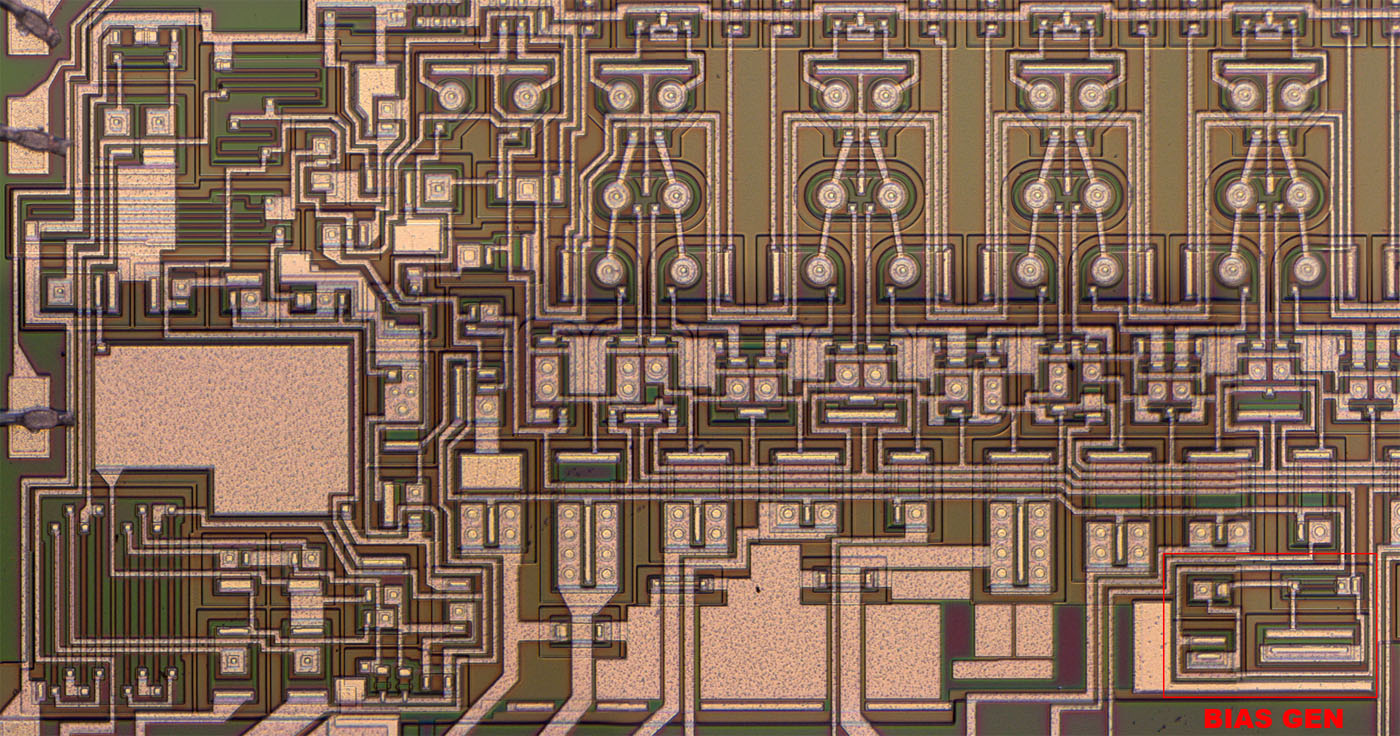
The elements that generate the bias voltage have been integrated into the center of the DAC. Presumably this was done to ensure that the circuit and the current sinks have the same temperature.
https://www.richis-lab.de/DAC19.htm 